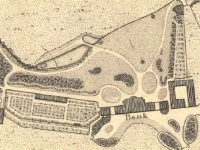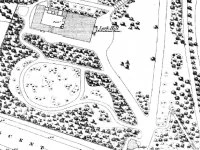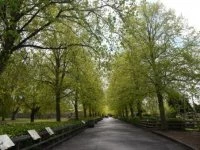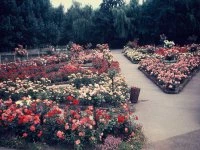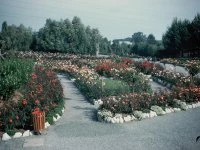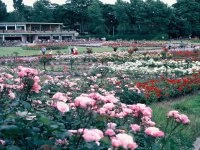Sites Supplied
Caldwell's supplied plants to many customers in Cheshire, Lancashire, the surrounding counties, London and even as far away as the West Indies. Here we provide some information about some of the sites that they supplied. This page will be added to as we get more time to write up information discovered about sites where Caldwell's stock was supplied – if you can add to this, why not contact us. Click on a name, below to find out more.
The drive to Holland Ackers' house, Bank, led from White Cross Bank in Salford. The walk to the left of the image continued for some distance, heavily wooded, round two sides of the field, ending in a circular walk with two large ponds at the top end, back down to the pleasure grounds. This property demonstrates how kitchen and fruit gardens could be linked with shrubberies and pleasure grounds.
By 1850 Holland Ackers' house and garden had disappeared, having given way to a Brick Croft and Filtering Ponds associated with the Adelphi Dye Works, Print Works and Baths. By 2012, the site was a car park.
James Ackers' home, Lark Hill, was not far from his brother's. In 1846 its seven acres constituted nearly a quarter of the new Peel Park – one of the three Manchester parks created by Joshua Major and paid for by public subscription. The house was used for refreshments and subsequently became Salford Museum.
George Mottershead founded and opened Chester Zoo in 1931. Born in Sale 1894, the eldest of four children, George was taken to Belle Vue Zoo in Manchester where the animals were kept in traditional cages. George always dreamt of having a 'zoo without bars'. After serving in WWI, George and his young family moved to Shavington near Crewe and started a market garden and florist's shop. He sold pet birds and stocked exotic animals which proved a great attraction. In 1930 encouraged by interest in the animals, he acquired Oakfield House at Upton near Chester set in a nine acre estate. There he proposed his idea of a 'zoo without bars', much to the consternation of locals. After an enquiry the Ministry of Health gave permission for the zoo.
The first Head Gardener, Phillip Gallup was appointed in 1953 following a decision to develop the Zoo's ornamental gardens. Under Phillip the Zoo became a regular customer of Caldwell's purchasing trees, shrubs and many roses, with Mr Bill Caldwell as the main contact. The ornamental gardens became known for their floral displays. The roses flourished on well rotted animal manure! In 1973 Amateur Gardening said 'the most eye catching feature are the rose gardens', 20,000 rose bushes, hybrid tea roses and floribundas maintained by twenty eight gardeners. Following Phillip Gallup's retirement in 1976, his 'outstanding contribution .... (in) building up one of the North of England's horticultural showplaces' was acknowledged by Garden News .
Walter Worth joined the staff as Assistant Head gardener in 1960 and took over as Head Gardener in 1976. Walter said 'I did enjoy that job. I followed on from my predecessor in buying roses, shrubs and trees from Caldwell's in Knutsford'. His main contact was Don Leaman. Walter recalled: 'I would go to the nursery... to see all the roses in colour and just to see what kind of rose bush the variety is. We had, in my day, about 100 different varieties of roses in the zoo. It probably stretched to about 7,000-8,000 rose bushes, all from Caldwell's'; an article in the Chronicle on 8th July 1983 and Liverpool Echo refers to 15,000 roses. Walter was elected an Associate of Honour by the Royal Horticultural Society in 1985 for his services to Horticulture.
Zoo newsletters provide a valuable record of the development of Chester Zoological Gardens. In 1937 the Zoo began producing 'Our Zoo News', a member's magazine that included pieces by Phillip Gallup and was published periodically until 1962. The title changed to 'Chester Zoo News' which came out 12 times a year until 1982. 'Gardening News' formed a section each month as development of the zoo progressed, much of the information concerning bedding displays and indoor planting of, for example, the Tropical House. From the late sixties Gardening News items occurred less frequently and from about 1975 were called 'Gardening Notes'. Walter Worth was a regular contributor – his 'gardening notes' often focusing on the merit of particular shrubs, propagation and garden maintenance at the zoo.
For more information from the Zoo's newsletters see the attached document. More of Walter Worth's recollections may be found under 'memories'.

